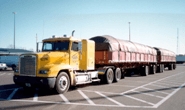Market Data

March 13, 2019
Burg: Trucking Issues Constrain the Economy
Written by Tim Triplett
Editor’s note: Jim Burg will be a panelist at Steel Market Update’s Steel Summit Conference Aug. 26-28 in Atlanta.
The U.S. economy is dependent on trucks. Trucking moves 50 percent of U.S. GDP. Seventy percent of all freight can only reach consumers by truck. Trucking employs 7.3 million workers of which 3.8 million are truck drivers. The link between economic growth and trucking is clear. Yet the trucking industry is constrained by a shortage of qualified drivers and other disincentives to new investment.
“To fix the problems, we first need to understand them,” said Jim Burg, president of James Burg Trucking, Warren, Mich., who spoke March 6 at the Fabricators and Manufacturers Association annual meeting in Nashville.
For trucking companies like Burg’s, the return on investment makes capital spending on new equipment significantly risky. Rolling stock costs 60 percent more than it did in 2006 when low-interest low-equity loans were readily available. Today, trucks and trailers can cost more than $300,000 and are much more costly to finance. “We depreciate tractors for seven years and trailers for 15 years, so that’s a long time to get the money back from that investment,” he said.
Three-fourths of North America’s trucking capacity is operated by fleets of five trucks or less—small businesses without a lot of resources or pricing power. Insurance costs have increased anywhere from 15-60 percent for small fleets, which makes it difficult for new companies to get into the business or existing companies to expand, he noted.
And, adding to the tight supply of trucking capacity, there are thousands of trucks sitting idle for lack of drivers. Long hours, difficult working conditions, nights away from home and earnings dependent on commissions scare most people away from a career as a truck driver. “There is a lack of qualified individuals willing to do this job for the current pay and lifestyle that it affords,” Burg said. Five years ago, the cost to recruit and train a new driver was about $2,000. Today, it’s $20,000. “Finding qualified drivers and turning them into steel haulers costs a lot of money.”
Last year, when the federal government imposed new safety rules that limit drivers’ hours behind the wheel, monitored by electronic logging devices (ELDs) in each vehicle, the shortage of trucking capacity immediately worsened. Drivers could no longer fudge their drive times on paper logs. Surprisingly, drivers don’t seem to mind being monitored, Burg said. “I used to think drivers all wanted to run hard and stretch the paper like I did. That attitude is gone. Guys like not being told they have to do something even when their body is telling them not to. As an operator, I have never slept better knowing that every one of my drivers is doing it right.”
One oft-heralded solution to the driver shortage is trucks that drive themselves. But fully autonomous vehicles are still 20-25 years away, Burg estimated, and will require major upgrades to the nation’s infrastructure.
“So, I am asking myself, do I want to expand? We need more certainty that we will get a return on that investment,” he said.







